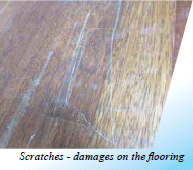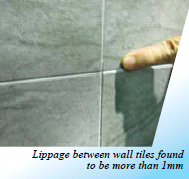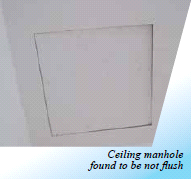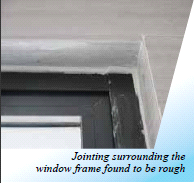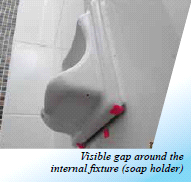WHEN you buy a new car, you look for the tiniest of scratches and chipped paint every time you park your car for the night. Every part of the vehicle will be scrutinised and microanalysis for a long time to come.
Similarly, new homes should be assessed from top to bottom because it is your right as a new homeowner to move into a defect-free house.
Defects Assessment can be done by your contractor's assessor, hired professional assessor, or yourself. All you need is QLASSIC and you will be well on your way towards a defect-free new house.
QLASSIC advocates Assessment Method 6+1 to scan and identify cracks, ill-fitting, chipped paints, and loose screws at your new house. Since Defects Assessment needs to be done carefully and covers up to the tiniest nooks of your home, it is wise to adhere to a checklist and a systematic workflow to ensure maximum efficiency of the assessment.
How to conduct 6+1 Method?
Equip yourself with the necessary tools required to conduct the assessment. Some of the tools are unit floor plans (a few copies as you would be making notes), pen or marker pen, camera, torchlight, stickers, tapping rod, measuring tape, Sales & Purchase Agreement (with relevant specifications and measurements), spirit level, L-square, steel wedge, steel gauge, and angle mirror.
Under the 6+1 method, six internal finishes, as well as mechanical and electrical fittings, will be examined. The six internal finishes are floor, walls, ceiling, doors, windows and fixtures. Fixtures include a wardrobe, kitchen cabinet, vanity top, mirror, bathtub, water closet, shower screen, sink, basin, signage, railing, unit number plate, and grill door.
Each of these six internal fittings will be scrutinised under five defect groups according to QLASSIC.
Assessing the floor
The defect groups for the floor are finishing, alignment and evenness, cracks and damages, hollowness and delamination, as well as jointing. While assessing the floor, you should make sure that there are no stain marks on the floor finishing, consistent colour tone, and no unduly patches on the floor finishing.
You should also make sure floor surface is even and equal or not more than 3mm over 1.20m and variance in staircase lengths of treads and risers must not exceed 5mm from dimension specified. There should be no hollow sound when tapped with a hard object or tapping rod and no sign of delamination such as carpet tiles peeling off.
As for jointing, jointing between floor finishes must be consistent, neat and aligned, the thickness of the skirting must be consistent and no visible gaps between and skirting as well as no holes, over grout, under grout and stains on the jointing.
Assessing the walls
The defect groups for walls are finishing, alignment and evenness, cracks and damages, hollowness and delamination, as well as jointing. Ensure there are no stain marks on wall, consistent colour tone and good paintwork with no paint drips and brush marks as well as good opacity, no rough or patchy surface from touch-up work.
For alignment and evenness, walls should be even with equal or not more than 3mm over 1.20m, meet at the right angle with equal or not more than 4mm over 300mm and the verticality of wall should be equal or not more than 3mm over 1.20m.
For wall jointings, there should be no holes, over grout, under grout and stains on the
jointing and the lippage between 2 tiles should not be more than 1mm.
Assessing the ceiling
The defect groups for ceilings are finishing, alignment and evenness, cracks and damages, roughness and patchiness, as well as jointing. The ceiling finishing should be free from stain marks with consistent colour tone and the paintwork should be of good opacity and with no brush marks.
Ceiling surface should be smooth, even, not wavy and not sagging, the edges of the ceiling to be straight and aligned and the ceiling manhole needs to be flush.
Jointing must be consistent, aligned and neat, the jointing surrounding ceiling manhole need to be neat and consistent, and there should be no visible gap between ceiling and wall.
Assessing the doors
The defect groups for doors are joints and gaps, alignment and evenness, materials and damages, functionality, and accessories defects. Some of the aspects involved in the defects assessment of the doors are there should be no visible gap between door and wall as well as the consistent gap between door leaf and frame, and the gap shall not be more than 5mm.
Apart from that, there should also be no visible gaps for joints at door leaf and frame, no stain marks and any visible damages including paint drip and brush marks, no sags, warp and sign of corrosion on door leaf and frame, door joints and nail holes filled up and sanded with good paintwork, ease in opening, closing and locking, no squeaky sound during opening and closing of the door as well as lockset should be functional.
Assessing the windows
The defect groups for windows are joints and gaps, alignment and evenness, materials and damages, functionality, and accessories defects. The checklist for joints and gaps includes no visible gap between window frame and wall, neat joints between the window frame and wall internally and externally as well as consistent and no apparent gaps for joints at window leaf and frame.
As for materials and damages, there should be no stain marks, louvred window with glass panels should be of the correct length, good paintwork or coating with no patchy touch-up mark and there should be no sign of corrosion.
The functionality of the windows involves ease in the opening, closing and locking, no squeaky sound during opening and closing of the door as well as no sign of rainwater seepage.
Assessing the fixtures
Just as the doors and windows, the defect groups for walls are joints and gaps, alignment and evenness, materials and damages, functionality, and accessories defects. The joints and gaps of the fixtures should be neat and consistent, and welding joints need to be grounded and flushed.
The alignment of the fixtures should be level and aligned while securely fixed, functional and safe. There should also be no sign of corrosion and missing or defective accessories.
Assessing mechanical and electrical fittings
The defect groups for mechanical and electrical fittings are joints and gaps, alignment and evenness, materials and damages, functionality, and accessories defects. The joints and gaps surrounding the mechanical and electrical fittings should be neat and consistent with no visible gap, properly sealed and marked.
All the fittings should be aligned, levelled and straight. There should be no chipping, cracks, visible paint stain or mortar drippings. The fittings should be securely fixed, functional and safe with no leakage at points.
The above criteria and must-dos are just a small part of the Qlassic checklist. The full version encompasses all the detailed aspects of the house and will be an excellent guide to a defect-free new home.
Want to know more? Download the “Quality Guidebook for Homeowners” by CIDB Malaysia here.


